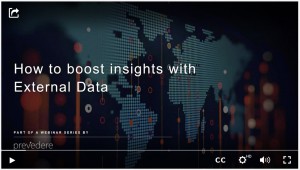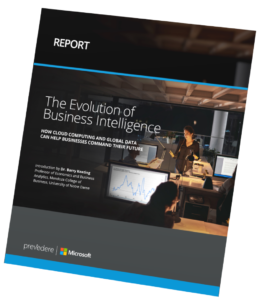Last Updated: March 26, 2019
External data can either save or cost your company millions, yet many organizations are not yet fully leveraging external data. As the threat of not having the right data and analytics to make strategic decisions intensifies in today’s rapidly changing data-driven world, external data is giving business leaders the ability to gain unique forward-looking perspectives about their business. External factors can influence up to 85% of a company’s performance, but according to Gartner, less than half report using external data.
In today’s digital age, data is the center of innovation and transformation. According to CEO Magazine, data has become the foundation of the analytics economy, making analytics an essential tool for turning data into the actionable insights that transform businesses. External data, however, may be the unsung hero of the analytics economy because it provides a holistic view of what is going on outside a company’s four walls.

External data can provide insight into the past while helping to predict future performance. Factors like wages, sentiment, weather patterns and more can affect what will happen in the coming months. But what types of external data should be used? And how should organizations use this data? In a recent webinar discussion, John Sydnor, Executive Vice President of Sales and Chief Operating Officer at Prosper Insights & Analytics joined Jessica Dolezal, Data Scientist at Prevedere, to shed some light on this important topic.
What Are the Best Uses of External Data?
The opportunities for leaders to incorporate external data into their planning are plentiful. It can be used to:
- Identify past trends: Companies can use total consumer spending, a figure from the Bureau of Economic Analysis (BEA), to gauge the strength of the economy. This might be of interest for companies in retail or CPG, so they can compare their historical performance with that of overall consumer spending trends.
- Benchmark industry growth: The Federal Reserve Economic Data (FRED) provides industry-specific sales data. For example, automotive manufacturers can see the number of sales for domestic vehicles trend over time to gauge the expected growth of their company compared to the industry.
- Identify leading indicators for the future: The most powerful use of economic data is to identify leading indicators. It’s important to note that leading indicators will differ for every company. Each organization should understand what a meaningful leading indicator is for them. For example, is employment a good leading indicator? Or might job openings be better?
- Understand consumer behavior: Leveraging rich survey data, such as that provided by Prosper, gives insight into understanding how consumers feel, what they want to purchase, and how much their spending habits will change over time. This type of data can help give the C-suite a 360-degree holistic view by region or demographic segment.
What Kind of Information Is Collected in Surveys and How Is It Used?
To understand consumer behavior, brands should have access to why shoppers feel the way they do and to what mediums are best to reach them. External first-party anonymous behavioral data complements internal data so that a holistic view of the consumer can be created by region or particular demographic segment.
The types of data collected in surveys include:
- Behavioral: How shoppers research and purchase products
- Psychographic/Social: How shoppers feel
- Future Intent: What shoppers intend to buy
This data is heavily used by financial service firms, retailers and CPG companies. CMOs, consumer activation departments, hedge funds and national associations also leverage survey data. For example, the National Retail Federation uses data provided by Prosper for its holiday sales forecasts each year.
Learn How AI Technology Can Utilize External Data to Plan for the Future
External factors impact nearly every industry. Economic and consumer data is available to help guide organizations into the future. External data can provide powerful leading indicators to future performance. Enter Prevedere’s Prevedere Predictive Analytics Cloud, the first augmented analytics solution that automatically predicts and quantifies the impact of external influences on future business performance.
Using the power of machine learning to rapidly analyze millions of global data series updated daily from hundreds of sources, Prevedere has helped global companies discover the specific external leading indicators that will impact their sales, costs or profitability.
To learn more about how external data boosts future insights, watch the full webinar here.
***
 In the Evolution of Business Intelligence report, Prevedere, an industry insights and predictive analytics company, has partnered with Microsoft and Dr. Barry Keating, professor of economics and business analytics at the University of Notre Dame, to describe the critical turning point currently facing traditional analytics, as technology and data merge to help business leaders make smarter, faster, forward-looking decisions. Read the full report >>
In the Evolution of Business Intelligence report, Prevedere, an industry insights and predictive analytics company, has partnered with Microsoft and Dr. Barry Keating, professor of economics and business analytics at the University of Notre Dame, to describe the critical turning point currently facing traditional analytics, as technology and data merge to help business leaders make smarter, faster, forward-looking decisions. Read the full report >>